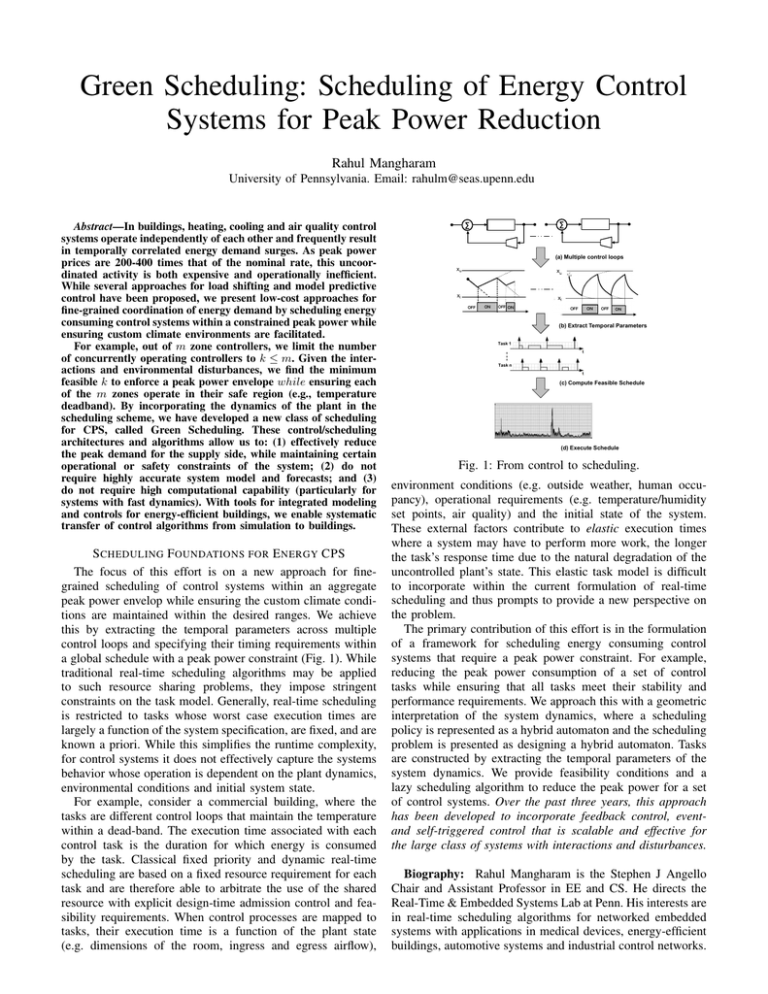Green Scheduling: Scheduling of Energy Control Systems for Peak Power Reduction
advertisement

Green Scheduling: Scheduling of Energy Control Systems for Peak Power Reduction Rahul Mangharam University of Pennsylvania. Email: rahulm@seas.upenn.edu Abstract—In buildings, heating, cooling and air quality control systems operate independently of each other and frequently result in temporally correlated energy demand surges. As peak power prices are 200-400 times that of the nominal rate, this uncoordinated activity is both expensive and operationally inefficient. While several approaches for load shifting and model predictive control have been proposed, we present low-cost approaches for fine-grained coordination of energy demand by scheduling energy consuming control systems within a constrained peak power while ensuring custom climate environments are facilitated. For example, out of m zone controllers, we limit the number of concurrently operating controllers to k ≤ m. Given the interactions and environmental disturbances, we find the minimum feasible k to enforce a peak power envelope while ensuring each of the m zones operate in their safe region (e.g., temperature deadband). By incorporating the dynamics of the plant in the scheduling scheme, we have developed a new class of scheduling for CPS, called Green Scheduling. These control/scheduling architectures and algorithms allow us to: (1) effectively reduce the peak demand for the supply side, while maintaining certain operational or safety constraints of the system; (2) do not require highly accurate system model and forecasts; and (3) do not require high computational capability (particularly for systems with fast dynamics). With tools for integrated modeling and controls for energy-efficient buildings, we enable systematic transfer of control algorithms from simulation to buildings. S CHEDULING F OUNDATIONS FOR E NERGY CPS The focus of this effort is on a new approach for finegrained scheduling of control systems within an aggregate peak power envelop while ensuring the custom climate conditions are maintained within the desired ranges. We achieve this by extracting the temporal parameters across multiple control loops and specifying their timing requirements within a global schedule with a peak power constraint (Fig. 1). While traditional real-time scheduling algorithms may be applied to such resource sharing problems, they impose stringent constraints on the task model. Generally, real-time scheduling is restricted to tasks whose worst case execution times are largely a function of the system specification, are fixed, and are known a priori. While this simplifies the runtime complexity, for control systems it does not effectively capture the systems behavior whose operation is dependent on the plant dynamics, environmental conditions and initial system state. For example, consider a commercial building, where the tasks are different control loops that maintain the temperature within a dead-band. The execution time associated with each control task is the duration for which energy is consumed by the task. Classical fixed priority and dynamic real-time scheduling are based on a fixed resource requirement for each task and are therefore able to arbitrate the use of the shared resource with explicit design-time admission control and feasibility requirements. When control processes are mapped to tasks, their execution time is a function of the plant state (e.g. dimensions of the room, ingress and egress airflow), ∑ ∑ (a) Multiple control loops xu xu xl xl OFF ON OFF ON OFF ON OFF ON (b) Extract Temporal Parameters Task 1 Task n (c) Compute Feasible Schedule (d) Execute Schedule Fig. 1: From control to scheduling. environment conditions (e.g. outside weather, human occupancy), operational requirements (e.g. temperature/humidity set points, air quality) and the initial state of the system. These external factors contribute to elastic execution times where a system may have to perform more work, the longer the task’s response time due to the natural degradation of the uncontrolled plant’s state. This elastic task model is difficult to incorporate within the current formulation of real-time scheduling and thus prompts to provide a new perspective on the problem. The primary contribution of this effort is in the formulation of a framework for scheduling energy consuming control systems that require a peak power constraint. For example, reducing the peak power consumption of a set of control tasks while ensuring that all tasks meet their stability and performance requirements. We approach this with a geometric interpretation of the system dynamics, where a scheduling policy is represented as a hybrid automaton and the scheduling problem is presented as designing a hybrid automaton. Tasks are constructed by extracting the temporal parameters of the system dynamics. We provide feasibility conditions and a lazy scheduling algorithm to reduce the peak power for a set of control systems. Over the past three years, this approach has been developed to incorporate feedback control, eventand self-triggered control that is scalable and effective for the large class of systems with interactions and disturbances. Biography: Rahul Mangharam is the Stephen J Angello Chair and Assistant Professor in EE and CS. He directs the Real-Time & Embedded Systems Lab at Penn. His interests are in real-time scheduling algorithms for networked embedded systems with applications in medical devices, energy-efficient buildings, automotive systems and industrial control networks.





